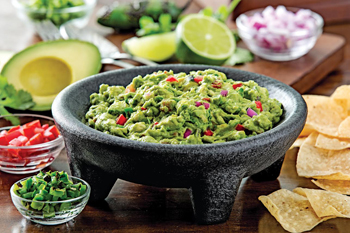While casual-dining brands in general have been buffeted by sales and traffic challenges, Chili’s Grill & Bar held profits steady in the third quarter with new menu initiatives, tabletop technology rollouts and a menu mix that provided insulation from rising commodity costs.
During an earnings call Wednesday, executives updated analysts on the 1,563-unit division of Dallas-based Brinker International Inc., which also owns the 45-unit Maggiano’s Little Italy brand, after reporting an 8.3 percent increase in profit for the March 26-ended third quarter.
“Our take on this space is that when we look at who’s winning and who’s struggling and in our own situation, you got to have a solid concept,” Wyman Roberts, Brinker’s chief executive and president, said during the call.
RELATED
• Chili’s, Maggiano’s 3Q same-store sales rise
• Brinker International CFO resigns
• More casual-dining news
Brinker reported net income of $56.3 million, or 82 cents per share, an increase from $52 million, or 71 cents per share, in the prior-year period.
“While traffic gains at Chili’s have been elusive, we believe that identifiable sales/margin initiatives will drive mid-teens earnings growth and market share gains over the intermediate term,” wrote analyst Lynne Collier of Sterne Agee.
Chili’s has also been able to avoid heavy use of discounting and coupons, analysts noted.
“You can play around on the fringe with some discounting,” Roberts said, “but if it becomes a primary driver — and there’s examples recent and past of people that have tried to use that to get them out of trouble or to move them from one place to another — I don’t think it’s proven to be a long-term strategy that holds.”
A better strategy, noted Roberts, is for a restaurant brand to offer a good value proposition as a baseline along with other initiatives. Chili’s has been focusing on three areas to help the brand succeed:
Expanding the Fresh Mex platform

Chili’s is expanding its Fresh Mex platform and just this week introduced a tableside guacamole presentation called “Guacamole Live,” new fajitas and new margaritas.
A spokesperson said that when a guest orders the new tableside guacamole, the server brings a Molcajete — a lava-like bowl — filled with fresh avocado chunks to the table along with all the ingredients, which include lime juice, chopped and roasted jalapenos, diced red onion, diced tomatoes and chopped cilantro. Servers engage the customers and serve the finished guacamole with tostada chips and salsa.
“To drive trial,” the spokesperson said, “Chili’s is promoting tableside guacamole in-restaurant on the feature card and through tabletop media. The new dish is also featured on the cover of the brand’s core menu.”
Roberts said the Fresh Mex platform has grown in the past six months to 20 percent of the entrée mix. Chili’s had long avoided promoting the Mexican platform, but that has eased since Brinker sold the more Mexican-focused On The Border concept in 2010.
“Our guests give us a lot of permission to play in that space, more so than any other bar and grill player,” Roberts added.
The Fresh Mex platform also provides good margins, analyst Collier said, and helped Brinker leverage a 100-basis-point reduction in cost of goods sold in the third quarter compared to the same period a year ago.
“We believe that guests perceive the Fresh Mex items as higher quality, and we believe many guests are ordering the Mexican bowls as a healthier entrée,” Collier wrote.
Completing tabletop technology rollout
Chili’s has just completed its rollout of new ordering and entertainment kiosks to all its company-owned stores two months ahead of schedule, and franchised units are not far behind, Roberts said, adding that the costs to the company are slight.
“We think that ultimately, [the technology] will increase the check average based on higher appetizer and dessert sales,” said Collier. “In late 2013, Chili's [vice president] of marketing noted that the units generated as much as a 20-percent increase in dessert sales in the original test markets. We also think that it can be a traffic driver longer-term as it reduces the wait time for the check and should enhance the guest experience.”
David Palmer, an analyst with RBC Capital Markets who gave Brinker an “outperform” rating, said in a note that the company is “focusing on the technology's ability to solicit more customer feedback and enhance guest experience.”
He continued, “Going forward, we believe Brinker will use the enhanced analytics and programming capabilities to further leverage the scale of Chili's against smaller competitors.”
Managing commodity inflation
Brinker’s management told analysts that they do expect commodity costs to be significant in the upcoming fiscal year, which begins June 26.
Palmer of RBC Capital Markets said, “Despite rising food inflation in key items such as beef and seafood, Brinker's commodity inflation was flat” in the third quarter.
“While many other restaurant chains, in particular casual-dining chains, will be facing rising margin pressure from food inflation, Brinker appears relatively well-positioned, with 46 percent of commodities locked in through the end of 2014,” Palmer said, adding that he expects costs to be about flat year-over year.
Roberts added that while Brinker’s brands do not plan price increases, the company remains aware of margins.
“We’re also very, very much aware of our price and the elasticity of price and what it does to drive traffic or put pressure on the traffic,” Roberts told analysts. “So we’re constantly evaluating those. … Our position right now is try and keep pricing as low as we can. In that 1- to 1.5-percent range would probably be a good number. …”
In the most recent March 26-ended third quarter, Brinker’s revenue rose 2.1 percent, to $758.4 million from $742.7 million a year earlier.
“The core Chili’s concept continues to gain share in a modestly declining casual-dining market, margins continue to rise on positive menu mix changes, and the outlook for strong financial dynamics — especially continued steady and significant cash flow returned to shareholders — remains highly visible,” Bryan Elliott, an analyst with Raymond James, said.
Contact Ron Ruggless at [email protected].
Follow him on Twitter: @RonRuggless

